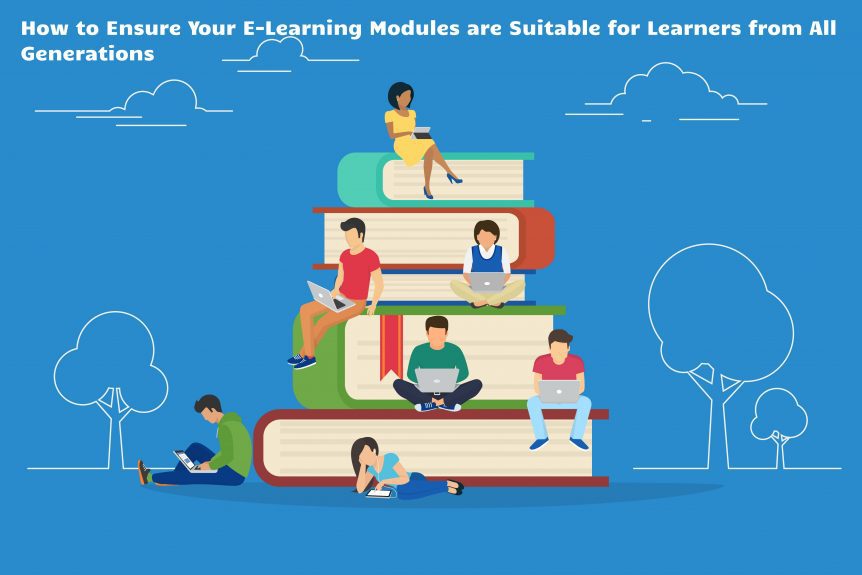How to Ensure Your E-Learning Modules are Suitable for Learners from All Generations
When creating a new e-learning module, there are many things you need to think about in relation to the target group of learners. Examples include their seniority in the organisation, current level of skill, competency level, and location.
One feature of e-learning audiences that is often neglected, however, is age. In other words, how do you make sure your e-learning modules are suitable for all your learners, whatever generation they come from?
We’ll look at the answers to this question below, but first…
Everyone is Different
Before we look at the tips on how to make your e-learning modules multi-generational, it’s important to remember that everyone is different.
It can be tempting to put all your learners into one of the commonly used categories – Baby Boomer, Millennial, Generation X, Generation Z, etc. – and then using this categorisation to make assumptions on their learning and technical capabilities.
Below, we will use generalisations like those above when referring to the characteristics of people from different generations. This is just for illustrative purposes as well as for brevity, though, i.e. they are meant to be a guide, not a rule.
After all, someone from an older generation can be more technically capable than an employee in their mid-20s who has grown up with computers, smartphones, and the internet, even though this goes against regularly made assumptions.
E-Learning is Suitable for All Generations
It’s also important to note that e-learning is a suitable training delivery method for all generations of learners. This applies even to learners that are not technically competent, not least because e-learning modules can be made to be easy to use and navigate.
These two features of e-learning eliminate many of the technical barriers that cause resistance from those who are not enthusiastic about using technology.
How to Make E-Learning Courses Appealing to Multiple Generations of Learners
Get Buy-In
This first tip has nothing to do with the differences in the ages of your learners. Whatever e-learning module you are creating, it’s important that all learners understand the benefits to them and to the business.
Make Sure You Understand Your Audience
Understanding your audience is essential for several reasons, but it also helps with ensuring your course appeals across generations. You need to know who the learners are, the skills they currently have, their attitude to learning, etc.
Don’t Try to Please Everyone
If your learners are from multiple generations, you won’t be able to include elements that appeal to them all. The module will just become disjointed, jarring, and cliched.
The best approach if you have a multi-generational group of learners is to take as neutral an approach as possible without compromising on engagement.
So, instead of incorporating elements to appeal to each specific generational group, focus instead on elements that will appeal to all.
Give Clear and Easy to Find Instructions
Give clear and easy to find instructions about what the learner should do next on each screen in your e-learning course. Don’t just assume that because there is a button, icon, or link that the learner will know they need to click/tap on it. You need to tell them.
By including these instructions, you won’t alienate users who know intuitively what to do, but you will help those who don’t.
Add Social and Communication Features
Social and communication features are ideal for those who prefer personal communication and interaction rather than interacting solely with technology. This preference for personal communication is an attribute often associated with older generations.
Social features also appeal to younger generations who are very comfortable and familiar with using social media.
Use Microlearning
Consider using a microlearning strategy to keep the interest of those with short attention spans.
Short attention spans are something often associated with younger generations, but microlearning strategies should appeal to everyone.
Empower Learners
Giving learners a degree of autonomy over their learning experience is something that can be beneficial for several generations. This includes, for example, younger learners who value choice as well as those in Generation X who like to have an input in their own growth and development.
Empowering learners could be anything from letting the learner complete modules on their own device at a time that suits them, to giving learners a say in the modules they need to complete based on their competency levels and capabilities.
Maximise Engagement
Include elements in your e-learning courses that have high levels of engagement. Gamification elements are a good example, as are scenarios.
Make the Content Relevant
Make sure the content of your e-learning module is relevant to the everyday experience of the learner. After all, using made-up examples, unrealistic scenarios, or embellished stories risks making learners feel patronised, particularly older learners, and will cause them to disengage from the module.
Use Neutral Language
Use conversational and friendly language in your e-learning course that is also neutral.
This means avoiding things like text speak and slang terms that may be familiar to younger audiences, but which may confuse older learners. The same applies to abbreviations and phrases predominantly used by a certain age demographic.
Take Care When Using Cultural References
Actors, bands, singers, movies, songs, sports stars, historical events, etc, may not be familiar to all generations. For example, a younger learner may not be familiar with a singer who was popular in the 1990s.
Appealing to Multi-Generational Learners
As you can see from the above, ensuring your e-learning courses are suitable for learners from all generations can be achieved. The approach you should take involves thinking about the group of learners as a whole rather than tilting the focus to one specific part of the group.

